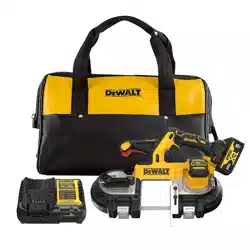Loading ...
Loading ...
Loading ...

English
10
Blade Tracking (Fig. A, H)
WARNING: To reduce the risk of serious personal
injury, turn tool off and remove the battery pack
before making any adjustments or removing/
installing attachments or accessories. An
accidental start‑up can causeinjury.
NOTICE: Excessive tightening of the adjustment screws
could result in damage to thesaw.
Your band saw is equipped with an adjustable blade tracking
mechanism which assures proper blade tracking at all times.
The blade is properly adjusted when it is sitting fully on
rubber tires
21
and lightly touching one or both of the rear
guide bearings
25
.
To Adjust the Blade Tracking (Fig. A, H)
1. Turn and open the blade tension lever
8
to allow access
to the tracking screw
13
.
2. Use a 13mm wrench to loosen the lock nut
7
(Fig.H).
3. Use a 4mm hex wrench
5
to turn the tracking screw
13
1/4 turn clockwise or counterclockwise (Fig.H).
nOTE: Turning the tracking screw clockwise moves
the blade toward the guide roller, turning the tracking
screw counterclockwise moves the blade away from the
guideroller.
4. Tighten the locking nut and close the blade tension lever
and blade guard. (It will be necessary to run the saw to
observe the tracking.)
5. Observe blade tracking between runs and repeat Steps
1–4 as necessary to achieve proper bladetracking.
4. When removing the blade, tension may be released and
the blade may spring free. SAW BLADES ARE SHARP. USE
CARE IN HANDLINGTHEM.
5. Inspect the guide rollers
20
and remove any large chips
which may be lodged in them. Lodged chips can prevent
rotation of the guide rollers and cause flat spots on the
guiderollers.
6. Rubber tires
21
are mounted on the pulleys
19
. The
rubber tires should be inspected for looseness or damage
when changing the blade. Wipe any chips from the
rubber tires on the pulleys with abrush.
nOTE: Do not use your hands to wipechips.
This will extend tire life and keep the blade from slipping.
If any looseness or damage occurs, the tool should be
brought to an authorized DeWALT service center for
repair or replacement as soon as possible. Continued use
of the tool with loose or damaged rubber tires will cause
unstable travel of the band sawblade.
7. Close the blade guard and securely latch the two
blade guard latches. Rotate the blade tension lever
8
counterclockwise 180degrees until itstops.
Installing and Removing Blades
CAUTION: Cut hazard. Blade tension lever is under
spring pressure. Maintain control of lever when
releasing bladetension.
WARNING: ALWAYS wear gloves when touching the
sawblade.
To Install Blade (Fig. A, D–G)
1. Rotate the blade tension lever
8
clockwise 180degrees
until it stops to release tension on blade (refer to
FigureA).
2. Turn the saw over and place it on a workbench ortable.
3. Unlatch the two blade guard latches
12
and open the
bladeguard.
4. Position the blade so that the teeth face out from the
saw and cut towards the work stop
6
.
blade direction
6
5. Slip blade into the guide rollers
20
and around both
pulleys
19
as shown in FigureD.
6. Make sure that the blade is fully inserted into the guide
rollers and positioned fully on the rubbertires
21
and
just touching the rear guide bearings
25
.
7. Rotate the blade tension lever
8
counterclockwise
until it stops and then close blade guard
11
and secure
latches. Make sure the teeth face away from the band
saw (as shown in the Figure in Step4).
8. Turn the saw on and off a few times to ensure that the
blade is seatedproperly.
Work Stop Adjustment (Fig. G)
To support large workpieces, the work stop should be
lowered following these steps:
1. Loosen the two screws
26
, shown in Figure G, with the hex
wrench
5
provided.
2. Move the work stop
6
to the desiredposition.
3. Securely tighten screws
26
.
To Remove Blade (Fig. A, D–H)
1. Rotate the blade tension lever
8
clockwise 180degrees
until it stops to release tension in blade (refer to
FigureA).
2. Turn the saw over and place it on a workbench ortable.
3. Unlatch the two blade guard latches
12
and open the
bladeguard
11
.
ASSEMBLY AND ADJUSTMENTS
WARNING:
To reduce the risk of serious personal
injury, turn unit off and
remove the battery pack
before making any adjustments or removing/
installing attachments or accessories. An accidental
start‑up can causeinjury.
Blades
This portable band saw is set up for use with
0.02" (0.5mm) thick, 1/2" (12.7 mm) wide and
35‑1/4"–35‑3/8" (896 mm–899 mm) long blades. DO nOT
use 0.025" (0.64mm) thickblades.
Loading ...
Loading ...
Loading ...
